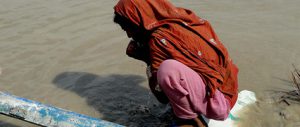Editor’s note: Water has always been a flash point between India and Pakistan. The two neighbours compete over use of the waters of the Indus River, the backbone of agriculture and industry in both states. As the Indian subcontinent was parted in 1947 to create the new state of Pakistan, the rivers were partitioned in 1960 through the Indus Waters Treaty (IWT). Five decades on, the radically altered landscape of Asia’s water resources has put the agreement at risk.
Both India and Pakistan face a deepening water crisis, driven by population growth, industrial demand and gross mismanagement of water resources. Climate change has added fuel to the flames. Melting Himalayan glaciers are projected to reduce the flow of water in the Indus Basin, particularly for Pakistan, which is now calling for an urgent revision of the treaty. As national policymakers increasingly couch water resources in terms of national security, hard battle lines have been drawn.
In an attempt to bridge the polarised debate, third pole presents two more nuanced perspectives. Indian journalist Joydeep Gupta (below) and Pakistani academic Maaz Gardezi (here) each offer a tentative way forward towards a more constructive cross-boundary dialogue over water resources, one that looks beyond national security and takes a more holistic ecological perspective.
As Pakistan went to the Court of Arbitration in The Hague once again in mid-August 2011, seeking an order for India to put on hold construction of the Kishanganga dam until the final decision of the court, the overwhelming response among Indian policymakers was: “Oh, not again.”
The project on the Jhelum River, one of the main tributaries of the Indus, has been opposed by Pakistan since it got off the drawing board. But India has steadfastly maintained that the run-of-the-river project follows the 1960 Indus Waters Treaty between the two countries to the letter. Just about everybody in India feels that the treaty is the best basis for apportioning the waters of the giant Indus river basin, that India as the upper riparian country has stuck to the treaty through war and peace, and that Indians are unfairly blamed for Pakistan’s water woes to cover up the inefficiency or worse of the water policymakers in Pakistan.
Given the near-unanimity of this view in India, and the near-constant rhetoric in Pakistan that “India is stealing our waters”, there is very little space for any level-headed, rational and scientific conversation on the subject. The trust deficit is so high – especially in India since many of the country’s terrorist attacks over the last three decades have been traced back to Pakistan – that anybody advocating a dialogue would be lucky not to be dubbed a spy. Anyway, Indian officials firmly hold, there is nothing to talk about: there is a treaty, India is sticking to it, that’s the end of the matter. And if it is not, the officials in New Delhi add, both governments have a permanent Indus Water Commission that is meant to sort out all issues, so why is there any need for anybody else to get involved?
Expectedly, this line of argument does not go down at all well in a water-stressed country like Pakistan, especially when the average Pakistani sees in the media that India is building structures upstream that can potentially choke off a part of the river flow. Knowing the extent to which it is under international scrutiny, India has not and is unlikely to build any structure that will reduce by even one cubic metre the volume of water it is supposed to supply to Pakistan under the treaty. But thanks to the trust deficit, few Pakistanis feel reassured.
Recent projects like the Kishanganga dam have no doubt added to the worry in Pakistan, though Indians are going blue in the face assuring the Pakistanis that the hydroelectricity project will not hold back any water at all, and that the project is being carried out as per the 1960 treaty. Indian planners point out that they cannot really go further and scrap the projects altogether – the parts of Indian-administered Kashmir through which the Indus and its western tributaries flow are chronically starved of electricity, and there are few economically viable options to meet the need other than hydropower.
It looks to be a situation where only open dialogue between India and Pakistan at every level – government, media, civil society – can clear the air. The chances of such a dialogue do not seem high at the moment, but it is nonetheless vital to keep striving for this. It is vital not only to build trust, but also because now there are two factors in the water-sharing puzzle that were not taken into account by the Indus Waters Treaty: deforestation and climate change.
The Indus and its main tributaries rise in the Tibet Autonomous Region (TAR) of China, and flow through India on their way to Pakistan and then the Arabian Sea. When the Indus Waters Treaty was signed in 1960, the volume of water was apportioned between India and Pakistan on the basis of the assumption that the flow of the water in the rivers would remain constant. This assumption is now in question due to these two factors.
While there are few official reports about the extent of deforestation in western TAR through which these rivers flow, there is plenty of anecdotal evidence that the already-sparse tree cover of the Tibetan Plateau is being rapidly denuded. Indian hydrologists have reported an increase in the silt load in the rivers as a result. They are expecting an effect on the water flow, but are uncertain of what the effect would be. The same goes for the effects of climate change. While some of the large glaciers of the Karakoram Range that feed these rivers are expanding, most of the glaciers in the western Himalayas – including the Karakoram Range – are receding due to global warming. The net effect on water flow is unpredictable, but likely to be negative, the hydrologists say.
So there is a treaty that apportions a certain amount of water between India and Pakistan. What happens to the treaty if that amount is no longer certain? How will the two countries amend the treaty – for which it does have a provision – for a fair water-sharing arrangement in the future? It requires a cool-headed, civilised dialogue to even start to answer this question. Then it requires a lot of scientific research in both countries to reduce uncertainties in the water flow projections. And it definitely requires close cooperation from the authorities in China, where the rivers originate.
Anybody advocating these steps would be considered dangerously naïve by most people in India and Pakistan today. But not to take these steps may prove even more naïve in the long run.
Joydeep Gupta is project director (south Asia) of chinadialogue’s third pole project.
Homepage image by International Rivers
Read "Tackling old fears in Pakistan", by Maaz Gardezi, here







